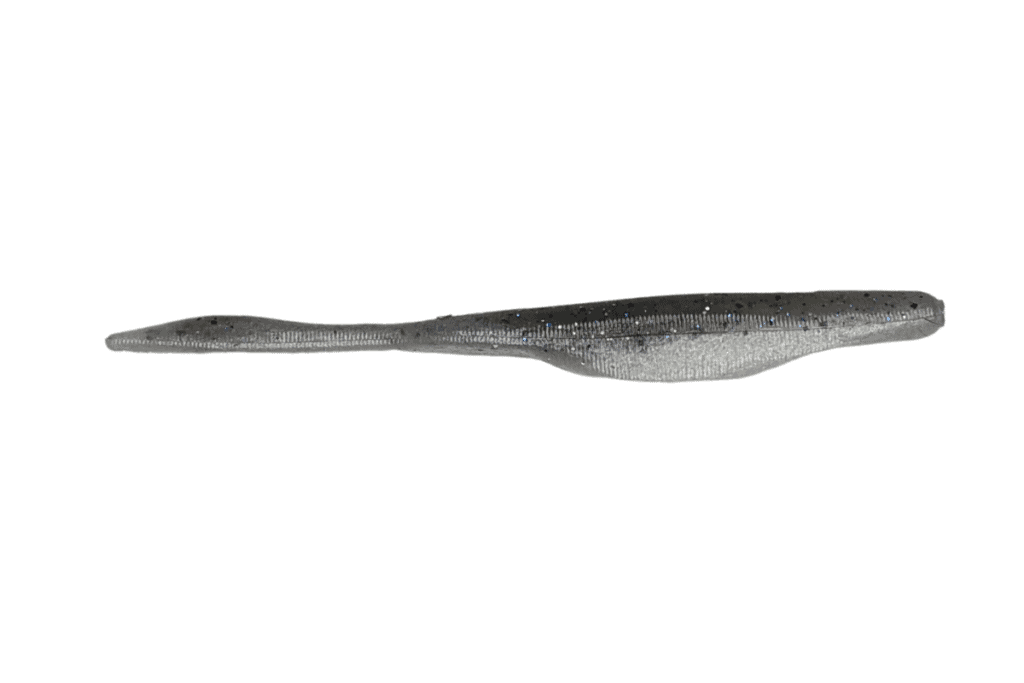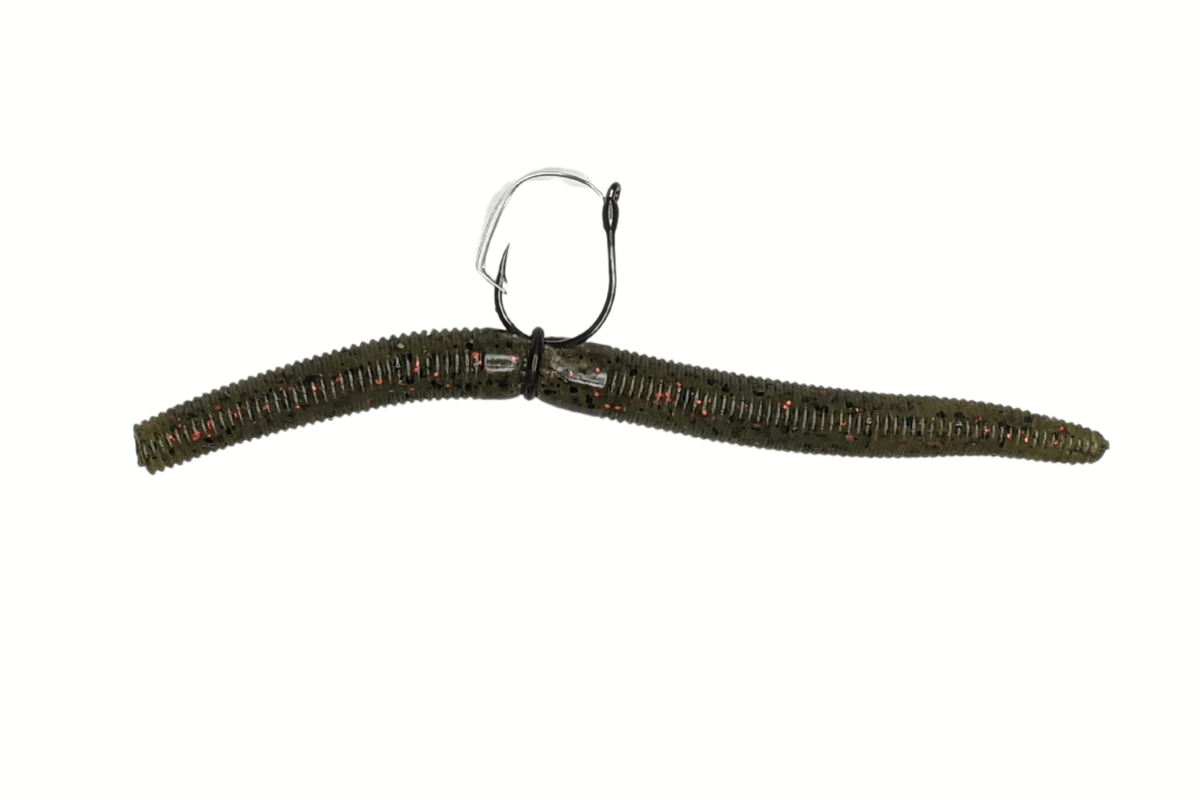There are times when bass will hit our lures and for some reason, they either miss it or do not commit to inhaling it. These are the moments when a follow-up lure can fool a fish into coming back to bite.
Follow-up lures are meant to give the bass another chance to hit a bait. After an initial missed strike, follow-up lures are immediately tossed into the same area. Baits like weightless soft jerkbaits, weightless stick baits, and drop shot rigs can be just the incentive the fish needs to hit again.
In this article, I will be covering popular follow-up lures as well as presentations that can coax that missed fish into coming back to inhale your new offering.
I Learned the Hard Way
Even though I have traveled the country chasing bass, there are always things to learn.
One of these moments happened to me while fishing a Bassmaster Open event on Lake Oneida in mid-state New York.
During practice, I had located a vast flat covered with sand grass. Smallmouth were cruising this flat and annihilating baitfish. Every few casts with a walk-the-dog topwater ended in a mean bronzeback taking the lure and running with it.
Then competition day came.
I jetted down the lake to the flat and anxiously started throwing the same topwater. In just a few seconds a smallie blasted it – but failed to hook up.
This happened again-and-again over the next hour.
My nerves were frazzled and frustration led me to abandon that area and try somewhere else.
I later learned, too late of course, that the smallmouth were slashing at the lure attempting to stun or kill it. They then would come back and devour the wounded shad.
Little did I know at that point.
This was the perfect situation for a follow-up lure and I did not recognize it at the time.
As I said, I learned the hard way twenty years ago. I have not forgotten the lesson.
What Makes a Good Follow-Up Lure?
There are many lures that can meet the criteria for a follow-up lure:
- Slow Rate-of-Fall
- Have Enough Bulk to Make a Decent Cast
- Can Be Fished Around Cover
- Look Natural
Any soft plastic that checks off these boxes can be labeled in the follow-up category.

Slow Rate-of-Fall
This may be the most important criteria on the list.
Often, the lure that is initially missed by a bass is something that is moving. Topwaters, swim jigs, crankbaits, bladed jigs, spinnerbaits, etc.
A lure that is either being burned or presented in a horizontal manner has the chance for finicky bass to swat at it but not take it. Or, in the case of the above-mentioned smallmouth, the predator is attempting to stun the bait.
A slow, sinking fall is often achieved by throwing a weightless soft plastic.
A version that is heavily impregnated with salt will still drop through the water column with an enticing action, yet the salt is heavy enough to offer a lengthy cast.
Most of the time, after a bass short-strikes a lure, they will hit the follow-up bait on the drop. Anglers need to be aware the lure most likely will never reach the bottom. Line watching is a key component to being successful with a follow-up bait.
I like to use braid that is hi-vis to enhance the chance of seeing the line twitch when a bass takes it.
Ability to Make a Decent Cast
When anglers are throwing big walking topwaters, spinnerbaits, crankbaits, and traditional horizontally presented offerings, long casts are the norm.
The follow-up lure needs to be able to reach the same distance in case the missed strike happens early in the presentation.
As mentioned above, salt-impregnated soft plastics are tossed with ease, yet still offer an enticing sinking action.
These casting criteria with lighter lures mean spinning gear is the best option for a follow-up bait.
Even ultra-light offerings, like a Ned Rig, can reach extreme distances with the proper spinning setup. A braided line is one way in which an angler can reach maximum distance with follow-up lures.
The low-memory and slick coating on braid mean there is little friction as the line unfurls through the guides of the spinning rod.
The spinning gear will also help when fishing in a strong wind and a follow-up presentation is needed.
The Ability to be Fished Around Cover
It is frustrating to have a bass miss our initial lure presentation and then follow it up with a soft plastic that immediately becomes hung in the cover.
Using Texas-rigged lures as well as hooks with weed guards can be just enough deterrent to keep the cover from fouling the presentation.
In an ideal situation, the fish we are targeting will inhale that lure before it has a chance to become entangled, but there is no need to take the chance.
Depending on the make-up of your home water, there may be lures that are better suited to certain situations.
Weightless wacky-rigs do great around vegetation, rocks, and more open water.
Weightless soft jerkbaits excel in those situations as well, but can also be worked around heavy wood cover without hanging up.
Appear Natural
When bass initially fail to hook up on our first lure, there is usually a reason.
Many times the predator turns away at the last instant because something didn’t look right. Our presentation cadence may have changed, they saw the boat, a piece of vegetation fouled the hook, etc. The reasons are vast.
I like to be safe and keep the follow-up lures looking as natural as I can. This may mean using a lighter line and closely mimicking the forage we think the bass are feeding on at that moment.
Small movements are also critical.
It doesn’t always work to follow-up a fast-moving lure with another fast-mover. That is where the slow rate-of-fall helps out.
If the follow-up lure does not get inhaled soon after hitting the water, presenting the lure in the most natural and subtle manner for a few feet can draw that bass out.
Rigged-and-Ready
This is where most of us fall short.
We know that a follow-up lure needs to be ready at all times. It is nice to have a rod solely dedicated to meet the demand when needed.
If you are an angler that always has a wacky-rig tied on, then you are in good shape.
I do a better job of always having a follow-up ready when I know I am on notorious smallmouth waters. When I am on traditional largemouth lakes I often have so many different lures tied on I may overlook the follow-up offering.
Then I need it and don’t have it.
You think I would learn.
Careful Presentation
When a bass misses the initial lure, it is best to reel the first line all the way in before tossing the follow-up out.
Besides legal implications in some states and violating tournament rules, it can create total havoc if a bass engulfs the follow-up and then becomes entangled in the other line sitting in the water.
This is one of the instances when high-speed reels are nice.
It is also important to try and place the follow-up lure as close to the area where the missed strike occurred.
Smallmouth that are in a stun-and-then-eat mode will circle around to exactly the same spot where they swatted at the first bait.
Missing the target by a few feet can mean a missed bite.
If the water has some stain to it or is dirty, the accuracy of the follow-up lure is even more important since the bass will be keyed in from their lateral line more than sight.
Don’t Overlook the Drop-Shot Rig
Weightless wacky-rigs and soft jerkbaits get top billing in the follow-up category, but a drop-shot rig can have surprising results as well.
The ability of the rig to hold a lure off the bottom and let the bass zone in on it leads to many strikes as a follow-up offering.
The leader length may need to be adjusted depending on the cover and the overall depth of the location, but once adjusted, it may be one of the better follow-up presentations you can use.
Final Thoughts
There are times when we never need a follow-up. The bass hit with a vengeance and things almost appear too easy.
But when these favorite fish of ours are in that short-striking mood, a follow-up lure can literally double your catch rate and save lots of frustration.
Make sure that your follow-up lures have the following:
- Slow Rate-of-Fall
- Have Enough Bulk to Make a Decent Cast
- Can Be Fished Around Cover
- Look Natural
Tight lines. Be safe and go out and encourage someone today. You never know how you may change their life forever.
Isaiah 6:8

